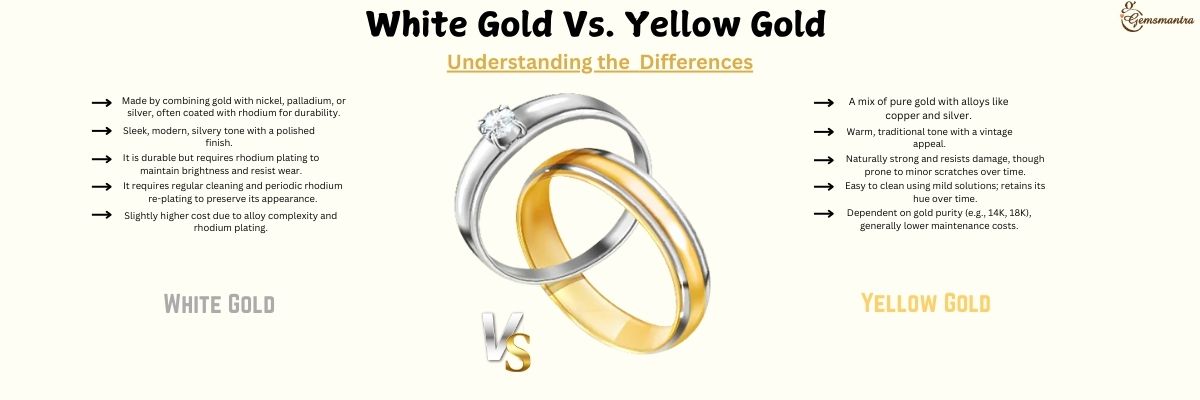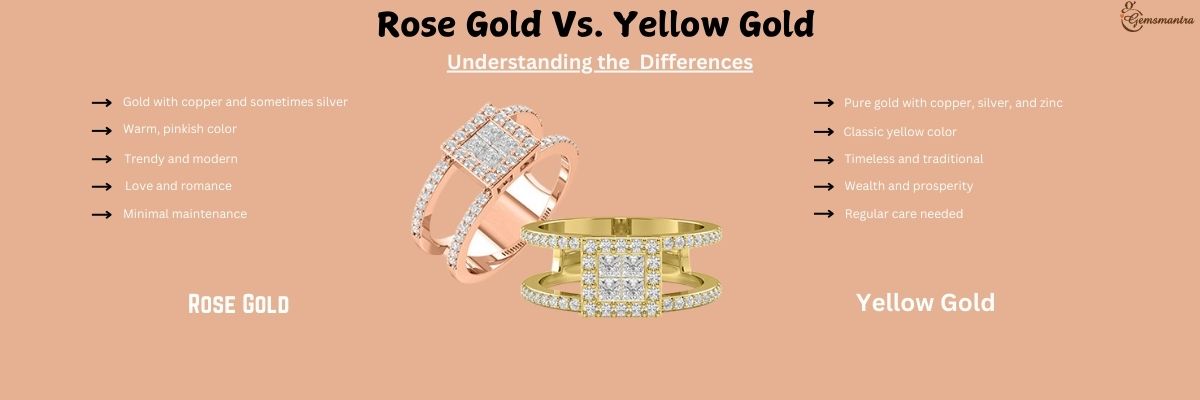
The Gold Debate: Yellow Gold vs. White Gold – Which Is Right for You?
Gold, in general, is quite common for making ornaments, as lots of people are fond of this due to the aesthetics or as a means of displaying one's status. However, white gold does not have such a huge fan base compared to the immense popularity of yellow gold. The Yellow gold vs white gold debate has remained a topic over time. Quite often, while choosing between both, one usually wonders which would be more costly. The price of gold is dependent on its content, no matter the color. White gold is formed by alloying gold with metals like nickel, palladium, or silver, often plated with rhodium to improve its whiteness and durability. This complexity of the alloy affects the price of white gold in the market, along with the other metals present.
Yellow Gold vs White Gold: A Detailed Comparison
Gold always exudes classic elegance and is, in most cases, a prized possession, given its versatility. Among the myriad of popular varieties available, a few stand out within the domain of jewelers' most common referrals: yellow and white gold. In that case, should a choice between both still seem very hard to make, then keep reading, for here goes the rule that shall direct your way forward properly.
Comparison: Yellow Gold vs. White Gold Under Different Heads.
1. Composition and Appearance
Yellow Gold: Yellow gold is a mix of pure gold and alloys like copper and silver. Typical purities are 14K (58.3% gold) and 18K (75% gold). Higher karat gold offers richer color but is softer, while lower karat gold is more durable and affordable for everyday jewelry.
White Gold: White gold is an alloy of pure gold mixed with metals like silver or palladium for a silver hue and enhanced durability. It is often coated with rhodium for a shiny finish and scratch resistance, but the fluctuating price of rhodium may cause this plating to wear off and require re-plating.
2. Durability
Yellow Gold: This naturally occurring metal is quite durable and resistant to wear. Although it may scratch over time, yellow gold retains its color, which has made it a long-time favorite for jewelry.
White Gold: To make it white, alloyed gold with metals like nickel and palladium. It is strong but may need rhodium plating to remain bright due to wear or reaction with skin. Rhodium plating also provides additional protection from scratching for white gold jewelry.
3. Maintainenace
Yellow Gold: The key maintenance task for yellow gold is to clean it regularly to eliminate dirt and grime that can build up over time. A mild cleaning solution can effectively clean yellow gold jewelry, ensuring it retains its shine and brilliance. It's essential to remove any leftover residue and buff it with a soft cloth to avoid scratches.
White Gold: Because of its characteristics, white gold demands additional care. The rhodium plating can diminish over time, necessitating replating to preserve its look. Regular checks and cleaning are also advised for white gold jewelry; consistent cleaning is essential to maintaining its longevity and classic appearance.
4. Cost
Yellow Gold: The price of yellow gold largely depends on the purity of the metal, because of which, for every gram, the price is based on karat value. Maintenance is not that expensive since there is no re-plating to be done usually. However, the cost remains dependent on karat (such as 18K, 14K).
White Gold: The inclusion of metals like palladium, which can have fluctuating prices, and the additional rhodium plating process contribute to white gold’s slightly higher cost compared to yellow gold in some cases. For example, a white gold piece could be $1,000, roughly $1,200.
5. Style and Popularity
Yellow Gold: Yellow gold has both classic and vintage aspects, making it a much preferred choice for most people leaning toward classic jewelry. It carries a soft, warm shade that complements most skin tones and further drives up the dramatic contrasts of the opulence coming from any colored gemstone. In that effect, yellow gold transforms into a beautiful base for heritage pieces, greatly cherished by more than one generation as a meaning of love.
White Gold: White gold is known for its modern and sleek appearance, giving a very chic and contemporary look. It has a cool, silvery tone that perfectly complements cool skin tones and makes the sparkle of diamonds even more brilliant. Thus, it will be the favorite of those who love simple designs yet are elegant in appearance. The polished finish is usually improved by rhodium plating, which further enhances durability and gives a touch of luxury—just perfect for modern-day lovers of jewelry.
6. Resale Value
Yellow Gold: Because of its purity and traditional appeal, yellow gold tends to hold a higher resale value. Since the alloys in yellow gold contain more pure gold than white gold, their inherent value remains relatively stable. Its timeless nature also makes it a preferred choice for buyers, especially in markets where gold is valued for its cultural and investment significance.
White Gold: On the other hand, valuable white gold often resells for less than yellow gold. The reason for this is due to the other added alloys, such as nickel or palladium, which dilute the pure gold content. In addition, white gold usually has to be plated with rhodium to give it a bright shine, and over time, replating may become necessary, thus further reducing its perceived value in resale.
Yellow Gold vs. White Gold: Comparison Table
|
Factor |
Yellow Gold |
White Gold |
|
Composition |
A mix of pure gold with alloys like copper and silver. |
Made by combining gold with nickel, palladium, or silver, often coated with rhodium for durability. |
|
Appearance |
Warm, traditional tone with a vintage appeal. |
Sleek, modern, silvery tone with a polished finish. |
|
Durability |
Naturally strong and resists damage, though prone to minor scratches over time. |
It is durable but requires rhodium plating to maintain brightness and resist wear. |
|
Maintenance |
Easy to clean using mild solutions; retains its hue over time. |
It requires regular cleaning and periodic rhodium re-plating to preserve its appearance. |
|
Cost |
Dependent on gold purity (e.g., 14K, 18K), generally lower maintenance costs. |
Slightly higher cost due to alloy complexity and rhodium plating. |
|
Style |
Timeless and classic, it pairs well with colored gemstones and suits warm skin tones. |
Modern and chic, it enhances diamond brilliance and complements cool skin tones. |
|
Resale Value |
Higher resale value due to its higher gold content and traditional appeal. |
Slightly lower resale value due to additional alloys and re-plating requirements. |
Conclusion
So, in the final analysis, the choice between yellow and white gold comes down to personal preference and priorities. Yellow gold has much going for it: it is timeless, classically beautiful, easy to maintain, and holds a higher resale value due to its traditional purity. It will be perfect for those who will appreciate the associated vintage charm and cultural meaning. On the other hand, white gold boasts its modern look and gives an extra level of strength and brilliance when combined with diamonds. It does, however, require a little more upkeep because of rhodium plating and perhaps has a slightly lower resale value, but the modern aesthetic really makes it a favorite for minimal, stylish designs. Both options have that something which is surely going to make it just perfect for everyone's taste and on any occasion.




